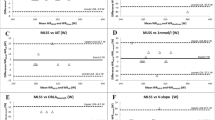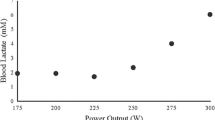Summary
To determine the effect of the duration of incremental exercise on the point at which arterial blood lactate concentration (HLa) increases above the resting value (anaerobic threshold: AT) and on the point at which HLa reaches a constant value of 4 mM (onset of blood lactate accumulation: OBLA), eight male students performed two different kinds of incremental exercise. A comparison of arterial HLa and venous HLa was made under both conditions of incremental exercise. The incremental bicycle exercise tests consisted of 25 W increase every minute (1-min test) and every 4 min (4-min test). At maximal exercise, there were no significant differences in either gas exchange parameters or HLa values for the two kinds of incremental exercise. However, the peak workloads attained during the two exercises were significantly different (P<0.01). At OBLA and AT, there were no significant differences in gas exchange parameters during the 1-min and 4-min tests except for the workload (at OBLAP<0.01; at ATP<0.05). When venous blood HLa was used instead of arterial HLa for a 4-min test, AT was not significantly different from that obtained by arterial HLa, but OBLA was significantly different from that obtained by arterial HLa (P<0.05). On the other hand, for the 1-min test, venous HLa values yielded significantly higher AT and OBLA compared with those obtained using arterial HLa (P<0.01).
It was concluded that when arterial blood was used, there was no effect of duration of workload increase in an incremental exercise test on the determination of the AT and OBLA expressed in\(\dot V_{O_2 }\). On the other hand, when venous HLa was used instead of arterial blood, these points might be overestimated when a fast increase in workload, such as the 1-min test, is used.
Similar content being viewed by others
References
åstrand P-O, Rodahl K (1970) Textbook of work physiology. 1st ed. MacGraw-Hill, New York
Cerretelli P, Shindell D, Pendergast DP, di Prampero PE, Rennie DW (1977) Oxygen uptake transients at the onset and offset of arm and leg work. Respir Physiol 30: 81–97
Davis JA, Vodak P, Wilmore JH, Vodak J, Kurtz P (1976) Anaerobic threshold and maximal aerobic power for three modes of exercise. J Appl Physiol 41: 544–550
Davis JA, Whipp BJ, Lamarra N, Huntsman DJ, Frank MH, Wasserman K (1982) Effect of ramp slope on determination of aerobic parameters from the ramp exercise test. Med Sci Sports Exercise 14: 339–343
Farrell PA, Wilmore JH, Coyle EF, Billing JE, Costill DL (1979) Plasma lactate accumulation and distance running performance. Med Sci Sports 11: 338–344
Forster HV, Dempsey JA, Thomson J, Vidruk E, Dopico GA (1972) Estimation of arterial\(P_{O_2 } , P_{CO_2 }\), pH and lactate from arterialized venous blood. J Appl Physiol 32: 134–137
Hughson RL, Green HJ (1982) Blood acid-base and lactate relationship studied by ramp work tests. Med Sci Sports Exercise 14: 297–302
Ivy JL, Withers RT, Van Handel RJ, Elger DH, Costill DL (1979) Muscle respiratory capacity and fiber type as determinants of the lactate threshold. J Appl Physiol: Respirat Environ Exercise Physiol 48: 523–527
Jacobs I (1981) Lactate, muscle glycogen and exercise performance in man. Acta Physiol Scand [Suppl] 495
Kindermann W, Simon G, Keul J (1979) The significance of the aerobic-anaerobic transition for the determination of work load intensities during endurance training. Eur J Appl Physiol 42: 25–34
Kumagai S, Tanaka K, Matsuura Y, Matsuzaka A, Hirikoba K, Asano K (1982) Relationships of the anaerobic threshold with the 5 Km, 10 Km, and 10 mile races. Eur J Appl Physiol 49: 13–23
Rusko H, Rahkila P, Karvinen E (1980) Anaerobic threshold, skeletal muscle enzymes and fiber composition in young female cross-country skiers. Acta Physiol Scand 108: 263–268
Sjödin B, Jacobs I (1981) Onset of blood lactate accumulation and marathon running performance. Int J Sports Med 2: 23–26
Tanaka K, Matsuura Y, Kumagai S, Matsuzaka A, Hirakoba K, Asano K (1983) Relationships of anaerobic threshold and onset of blood lactate accumulation with endurance performance. Eur J Appl Physiol 52: 51–56
Wasserman K, Whipp BJ (1975) Exercise physiology in health and disease. Am Rev Respir Dis 112: 219–249
Wasserman K, Whipp BJ, Koyal SN, Beaver WL (1973) Anaerobic threshold and respiratory gas excange during exercise. J Appl Physiol 35: 236–243
Weltman A, Katch VL (1979) Relationship between the onset of metabolic acidosis (anaerobic threshold) and maximal oxygen uptake. Int Z Angew Einschl Arbeitsphysiol 24: 18–23
Whipp BJ, Koyal SN, Wasserman K (1974) Anaerobic threshold and O2 uptake kinetics for work increments of various durations. Med Sci Sports 6: 67–68
Whipp BJ, Davis JA, Torres F, Wasserman K (1981) A test to determine parameters of anaerobic function during exercise. J Appl Physiol 50: 217–222
Yeh MP, Cardner RM, Adams TD, Yanowitz FG, Crapo RO (1983) “Anaerobic threshold”: problems of determination and validation. J Appl Physiol: Respirat Environ Exercise Physiol 55: 1178–1186
Yoshida T, Nagata A, Muro M, Takeuchi N, Suda Y (1981) The validity of anaerobic threshold determination by a Douglas bag method compared with arterial blood lactate concentration. Eur J Appl Physiol 46: 423–430
Yoshida T, Suda Y, Takeuchi N (1982a) Endurance training regimen based upon arterial blood lactate: Effect on anaerobic threshold. Eur J Appl Physiol 49: 223–230
Yoshida T, Takeuchi N, Suda Y (1982b) Arterial versus venous blood lactate increase in the forearm during incremental bicycle exercise. Eur J Appl Physiol 50: 87–93
Yoshida T, Suda Y, Takeuchi N (1983) Anaerobic threshold of middle and old aged men. In: Ishiko T (ed) Physical fitness research. Baseball Magazine, Tokyo, pp 219–225
Author information
Authors and Affiliations
Rights and permissions
About this article
Cite this article
Yoshida, T. Effect of exercise duration during incremental exercise on the determination of anaerobic threshold and the onset of blood lactate accumulation. Europ. J. Appl. Physiol. 53, 196–199 (1984). https://doi.org/10.1007/BF00776589
Accepted:
Issue Date:
DOI: https://doi.org/10.1007/BF00776589




